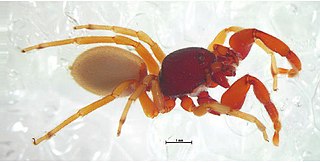
Ctenizidae is a small family of medium-sized mygalomorph spiders that construct burrows with a cork-like trapdoor made of soil, vegetation and silk. They may be called trapdoor spiders, as are similar species, such as those of the families Liphistiidae, Barychelidae, Cyrtaucheniidae and some species in Idiopidae and Nemesiidae. In 2018, the family Halonoproctidae was split off from Ctenizidae, leaving only three genera.

The wafer trapdoor spiders, family Cyrtaucheniidae, are a widespread family of spiders that lack the thorn-like spines on tarsi and metatarsi I and II found in true trapdoor spiders (Ctenizidae).

Crevice weaver spiders (Filistatidae) comprise cribellate spiders with features that have been regarded as "primitive" for araneomorph spiders. They are weavers of funnel or tube webs. The family contains 18 genera and more than 120 described species worldwide.

Plexippus is a genus of jumping spiders that was first described by Carl Ludwig Koch in 1846. It is considered a senior synonym of Hissarinus and Apamamia.
Proszynskiana is a genus of Asian jumping spiders that was first described by D. V. Logunov in 1996. It is named in honor of arachnologist Jerzy Prószyński.

Migidae, also known as tree trapdoor spiders, is a family of spiders with about 100 species in eleven genera. They are small to large spiders with little to no hair and build burrows with a trapdoor. Some species live in tree fern stems. They have a Gondwanan distribution, found almost exclusively on the Southern Hemisphere, occurring in South America, Africa, Madagascar, Australia, New Zealand and New Caledonia.

Palpimanidae, also known as palp-footed spiders, is a family of araneomorph spiders first described by Tamerlan Thorell in 1890. They are widely distributed throughout the tropical and subtropical regions of the world, the Mediterranean and one in Uzbekistan, but not Australia. They are not common and there is a high degree of endemism.
Filistata is a genus of crevice weavers that was first described by Pierre André Latreille in 1810.

Zaitunia is a genus of crevice weavers that was first described by Pekka T. Lehtinen in 1967.
Phyxioschema is a genus of Asian spiders in the family Euagridae. It was first described by Eugène Simon in 1889.
Synaphris is a genus of araneomorph spiders in the family Synaphridae, and was first described by Eugène Louis Simon in 1894. Originally placed with the tangle web spiders, it was moved to the Symphytognathidae in 1973, and to the Synaphridae in 2003.
Atmetochilus is a genus of spiders in the family Bemmeridae. It was first described in 1887 by Simon. As of July 2020, it contains 6 species.
Marusyllus is a genus of spiders in the family Salticidae, found in Russia, Central Asia, the Indian subcontinent and China.

Pseudomogrus is a genus of jumping spiders first described by Eugène Simon in 1937.
Ekaterina Mikhailovna Andreeva also known as Katarzyna Andrejewa-Prószyńska was an Uzbek arachnologist of Polish origin.








